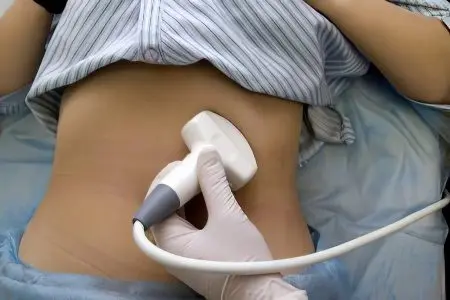Contents
What is atherosclerosis of the abdominal aorta?
Atherosclerosis of the abdominal aorta – a chronic pathology in which there is a violation of fat metabolism, as a result of which cholesterol plaques accumulate on the walls of the main artery. Over time, they undergo calcification and clog the lumen of the blood line. At the same time, a decrease in the elasticity of the walls of the aorta is also diagnosed.
The aorta is the largest vessel in the human body. It is divided into 2 branches: abdominal and thoracic, which supply blood to the organs of the corresponding cavities.
This vessel has a large diameter and strong, elastic walls. It must withstand the pressure of the blood ejected by our heart with great force so that it can reach the most remote corners of the body.
Since the aortic lumen is quite wide, the first symptoms of cholesterol deposits and calcification make themselves felt only in old age, when the plaques become very dense and significantly impair blood flow. Certain areas of tissue begin to suffer from ischemia, which develops due to insufficient blood supply.
Causes of atherosclerosis of the abdominal aorta

After many years of studying the pathology, the following reasons for its development were established:
Genetic predisposition;
Hypertonic disease;
Frequent nervous strain;
Lack of physical activity;
Diseases of the endocrine system, in particular, obesity and diabetes;
Metabolic disease;
Excess fatty foods in the diet;
Bad habits (drinking alcohol, nicotine);
Reducing the body’s defenses;
Infectious diseases in history.
Any of the above causes leads to a violation of lipid metabolism, which provokes the deposition of cholesterol in the lumen of blood vessels, which constantly accumulates and creates a plaque. It, in turn, causes an insufficient supply of blood to the organ fed by the affected vessel, and provokes its ischemia.
If the area of calcification completely closes the lumen of the aorta, this can cause sudden death of a person.
Symptoms of atherosclerosis of the abdominal aorta
The clinical picture in atherosclerosis of the abdominal aorta depends on the degree of progression and the stage of the disease:
Stage 1 – ischemic. It manifests itself in the form of periodic shortcomings in the transport of blood to organs. On the part of the heart, angina pectoris attacks are observed, abdominal pain may develop, as well as intermittent claudication;
Stage 2 – thrombonecrotic. It is characterized by the development of severe complications in the form of myocardial infarction, stroke, foot gangrene. They arise as a result of a thrombus detachment and blockage of smaller diameter aortic branches;
Stage 3 – fibrous. Diagnosed with a long course of pathology. It is characterized by the replacement of myocardial muscle tissue with fibrous fibers, which causes cardiosclerosis.
With atherosclerosis of the abdominal aorta, the patient is primarily concerned about the symptoms associated with the abdominal organs. This happens due to damage to the mesenteric branches that supply the intestines with blood. In this regard, there are complaints of pain around the navel, they are intermittent and periodically move. They usually occur after eating.
There is also flatulence, constipation. Some patients develop a tendency to diarrhea. Fecal masses become liquid, with an unpleasant odor. Due to a malfunction in the intestines, the absorption of nutrients is disrupted, which causes weight loss.
Very often, atherosclerotic plaques are localized in the bifurcation section of the abdominal aorta, this is the place where the vessel divides into 2 branches. In this case, the blood flow in the lower extremities is disturbed and there is a malfunction in the functioning of the pelvic organs.
With the localization of calcification in the aortic bifurcation, edema and hyperemia of the skin of the legs and feet are noted. Periodically, they begin to grow numb, become cold, sometimes necrotic ulcers develop. Intermittent claudication appears, when walking, patients complain of the occurrence of pain in the calf muscles, when the pain stops, they disappear.
On the part of the reproductive system in men, erectile dysfunction and infertility are often diagnosed.
On palpation, it is impossible to determine the pulsation of the arteries at the level of the navel, in the popliteal fossa, on the dorsum of the feet.
Diagnosis of atherosclerosis of the abdominal aorta

To identify atherosclerosis of the aorta is possible only with a comprehensive examination. Since pathology is more common in the elderly population, it is worth paying special attention to this particular group of patients. It is necessary to begin with the collection of an anamnesis and a visual examination of the patient.
After that, they move on to instrumental diagnostic methods. As a rule, they use:
electrocardiography;
Rheoencephalography;
Angiography.
These methods help to study the blood flow in the vessels that feed the heart, lower limbs and brain.
To determine the size of the heart and the degree of expansion of the aortic arch, a fluorogram is used. Also, ballistocardiogram, aortic electromyogram, pulse wave velocity, clearance factor, blood cholesterol level, sphygmogram can be used to detect atherosclerosis at the initial stage.
Treatment of atherosclerosis of the abdominal aorta
Treatment of atherosclerosis of the abdominal aorta requires an integrated approach. Be sure the patient must follow a diet that helps lower blood cholesterol levels. It is forbidden to use fatty meats, lard, butter, smoked meats, confectionery, pastries, alcohol, soda, strong coffee and tea.
Of the medications, drugs that affect the symptoms are used. These include hypotensive, diuretic, strengthening the walls of blood vessels and increasing their lumen.
Also, the doctor selects statins or fibrates – drugs that help block the production of cholesterol.
The surgical method of treatment consists in replacing the affected area of the aorta with a prosthesis. It is rarely used, only in cases where there is a threat of organ death.
Atherosclerosis of the abdominal aorta is a pathology that can cost a person their life. Therefore, it is worthwhile to conduct regular medical examinations and seek help in a timely manner if the corresponding symptoms occur.









